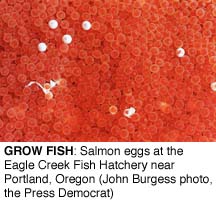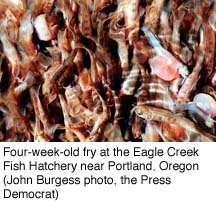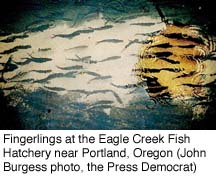forum
library
tutorial
contact

The Wild (and Not-So-Wild) Sex Life of Salmon
by Rebecca ClarrenHigh Country News, June 10, 2002
|
the film forum library tutorial contact |

|
The Wild (and Not-So-Wild) Sex Life of Salmonby Rebecca ClarrenHigh Country News, June 10, 2002 |
 A quick trip through the life cycle of a salmon, be it hatchery or wild, makes human development appear quite simple.
A quick trip through the life cycle of a salmon, be it hatchery or wild, makes human development appear quite simple.
In late summer or early fall, the female salmon deposits several thousand eggs in a shallow river bottom nest called a redd. In a mad flurry of kicking, the male simultaneously fertilizes the eggs with his milt. Using her tail, the female buries the eggs under the gravel riverbed where, if she's lucky, they stay protected.
That's in the stream. In the hatchery, things aren't so romantic. Just before fish have a chance to breed, they are killed, either chemically or with a club. Hatchery workers split open the female fish and spill her eggs into a bucket, then squeeze the milt from the male. The fertilized eggs are then kept in a dark incubator with continuously flowing, 50-degree water. Within two months, infant fish hatch.
 In the wild, juvenile fish spend from a month to a year, depending on their species, feeding in their home territory and avoiding predatory fish and birds. The majority of their hatchery cousins have it easy: they live in concrete tanks or raceways, with up to 100,000 of their brothers and sisters, protected from predators. Hatchery workers deliver feed daily.
In the wild, juvenile fish spend from a month to a year, depending on their species, feeding in their home territory and avoiding predatory fish and birds. The majority of their hatchery cousins have it easy: they live in concrete tanks or raceways, with up to 100,000 of their brothers and sisters, protected from predators. Hatchery workers deliver feed daily.
Then the salmon undergo a physiological change that is the stuff of science fiction comic books. As salmon prepare to head out to the ocean, where they will spend from six months to seven years (again, depending on the species), their skin turns silver, they become more sleek for better swimming, and their cells change to allow them to breathe in salt water.
"It would be like us going from a smoke-filled room into a mist-filled room," says Kathy Hopper, a fish pathologist. "We would have to put on a different kind of mask, change our clothes and put on a coat. (Pacific) salmon are absolutely amazing."
 While scientists have yet to figure out what spurs salmon to return to the rivers so many years later, the theory is that the length of summer daylight cues salmon that it's time to go home. Salmon have very sensitive nerve cells in two blind sacs, called nares, and they follow the smells of the river where they were born all the way home. Hatchery fish return to the concrete raceway where they were raised, to be killed and spawned once again. Wild fish do what their parents did before them: spawn and then die, their decomposing bodies then adding nutrients to the stream.
While scientists have yet to figure out what spurs salmon to return to the rivers so many years later, the theory is that the length of summer daylight cues salmon that it's time to go home. Salmon have very sensitive nerve cells in two blind sacs, called nares, and they follow the smells of the river where they were born all the way home. Hatchery fish return to the concrete raceway where they were raised, to be killed and spawned once again. Wild fish do what their parents did before them: spawn and then die, their decomposing bodies then adding nutrients to the stream.
learn more on topics covered in the film
see the video
read the script
learn the songs
discussion forum
